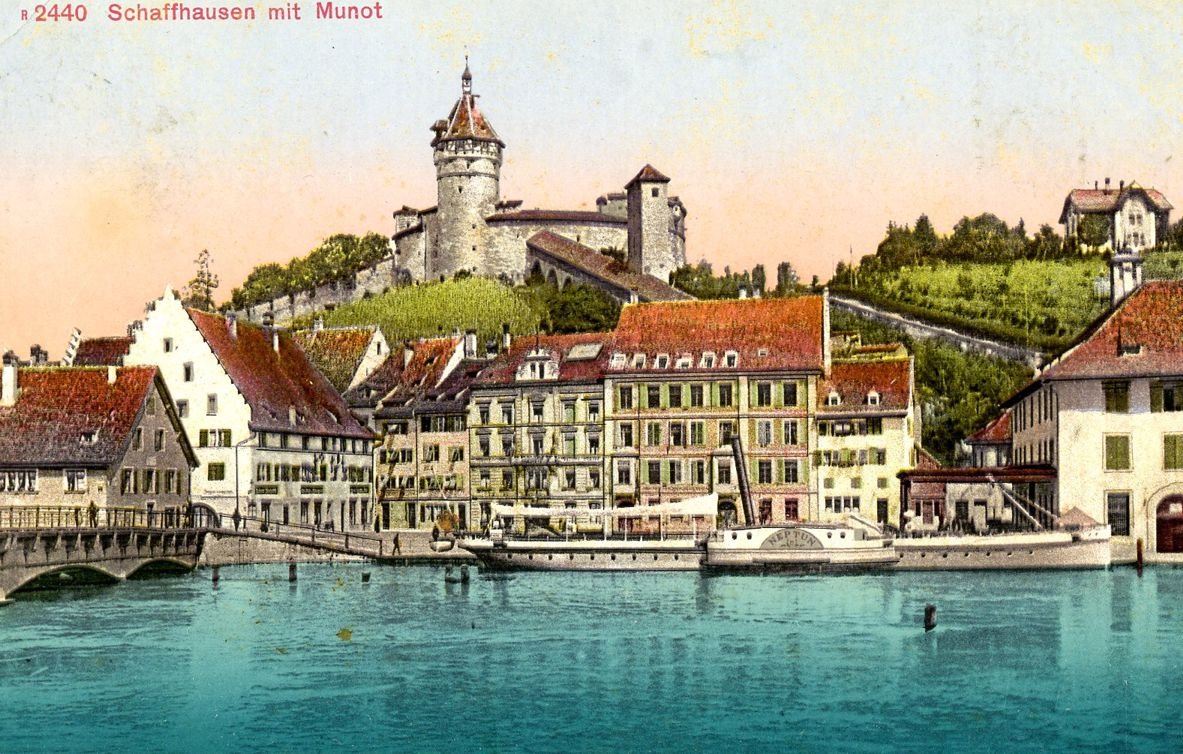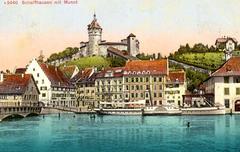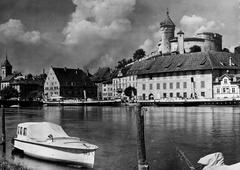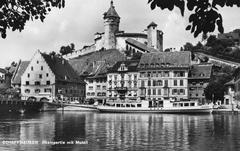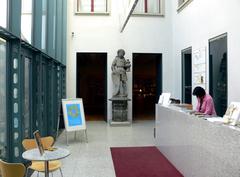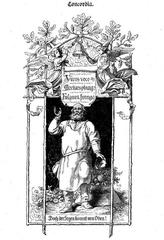Munot Schaffhausen Visiting Hours, Tickets, and Travel Guide
Date: 15/06/2025
Introduction
Rising above the historic city of Schaffhausen, Switzerland, Munot Fortress is a remarkable example of Renaissance military architecture and a living symbol of Swiss heritage. Constructed between 1564 and 1589, Munot was conceived during a period of political and religious transformation, following Schaffhausen’s accession to the Swiss Confederation and the Reformation. Its distinctive circular design, robust stone walls, and strategic hilltop position reflect both the defensive innovations of the 16th century and the civic pride of Schaffhausen’s citizens (MySwitzerland; Munot.ch; SpottingHistory).
Today, Munot serves as both a historical monument and a dynamic cultural center. Visitors can ascend its ramparts for panoramic views, explore its unique architecture, participate in cultural events, and experience centuries-old traditions like the nightly ringing of the Munot bell. This detailed guide provides everything you need to plan your visit, including practical travel tips, accessibility information, ticketing, and highlights of nearby attractions.
Table of Contents
- Introduction
- Origins and Construction of Munot
- Architectural Features and Defensive Role
- Munot’s Historical and Civic Significance
- Visiting Munot Fortress
- Nearby Attractions in Schaffhausen
- Frequently Asked Questions (FAQ)
- Visuals and Media
- Conclusion and Visitor Recommendations
- Sources and Official Links
Origins and Construction of Munot
Munot Fortress was commissioned in the mid-16th century as Schaffhausen’s answer to the changing nature of warfare and city defense. Following the city’s integration into the Swiss Confederation in 1501 and the local embrace of the Reformation in 1529, civic leaders prioritized a modern fortress to protect the city and its vital trade routes along the Rhine. Designed by city master builder Heinrich Schwarz and inspired by Renaissance fortification theories (notably those of Albrecht Dürer), Munot replaced earlier medieval defenses and was completed in 1589 after 25 years of construction (myswitzerland.com; Wikipedia).
Architectural Features and Defensive Role
Circular Plan and Renaissance Influence
Munot’s ring-shaped layout is a rare example of Renaissance military design in Switzerland. Its thick stone walls—up to 4 meters—form a circular bastion with a central courtyard, topped by a watchtower. This configuration allowed for 360-degree surveillance and defense against artillery, a significant advancement compared to earlier medieval castles (SpottingHistory; MySwitzerland).
Structural and Defensive Elements
- Casemates and Caponnières: Vaulted casemates radiate from the courtyard, historically used for artillery and troop accommodation. Caponnière galleries enabled defenders to fire along the moat’s base (Explorial).
- Spiral Staircase and Observation Deck: A stone spiral staircase leads to the open-air battlements, offering expansive views over Schaffhausen, the Rhine, and the surrounding landscape (Explorial; MySwitzerland).
- Moat and Vineyard: Munot is surrounded by a dry moat (home to fallow deer since 1905) and a vineyard cultivating Blauburgunder and Pinot Gris grapes for the local “Munötler” wine (Munot.ch).
- Gun Emplacements: The fortress’s design incorporated innovative gun placements and thick walls to absorb artillery fire, though these features were nearly obsolete by the time of completion (MySwitzerland).
Symbolic and Civic Features
- Munot Bell and Watchman’s Quarters: The Munot bell, cast in 1589, is still rung by hand daily at 9 p.m., a tradition marking the closure of city gates and connecting generations of Schaffhausen residents (Munot.ch; Switzerland-Highlights).
- Civic Pride: The scale and cost of Munot—equivalent to 800 townhouses—demonstrate its enduring importance as both a defensive work and a symbol of Schaffhausen’s prosperity (Wikipedia).
Munot’s Historical and Civic Significance
Key Events and Traditions
Munot’s only recorded military engagement occurred in 1799 during the Napoleonic Wars, when French troops briefly occupied it before withdrawing. More enduring than its military role are the fortress’s traditions and community functions (myswitzerland.com).
Community Stewardship and Cultural Events
- The Munotverein: Founded in 1839 by Johann Jakob Beck, the Munotverein (Munot Association) is responsible for the fortress’s preservation and for organizing events (munot.ch).
- Annual Festivals: Key events include the Children’s Festival, which brings together primary school children for games and fireworks, and the Munot Ball, featuring the traditional quadrille dance and the evening bell ritual (munot.ch).
- Cultural Hub: Throughout the year, Munot hosts concerts, theater performances, open-air cinema nights, and seasonal festivals, transforming the fortress into a vibrant center of community life (munot.ch).
Visiting Munot Fortress
Hours, Tickets, and Accessibility
- Visiting Hours:
- May to September: 8:00 AM – 8:00 PM
- October to April: 9:00 AM – 5:00 PM
- Hours may vary for special events or holidays. Always check Munot’s official website or Schaffhausen Tourism for updates.
- Tickets and Entry Fees:
- General admission is free.
- Guided tours and some events may require tickets or advance booking (explorial.com).
- Guided Tours:
- Available upon request or during scheduled times; booking in advance is recommended for groups (munot.ch).
- Accessibility:
- Access is via a steep stairway (Munotstieg) or the 277-step Bubatz-Treppe.
- Wheelchair access is limited; contact local resources or the site for detailed accessibility information (Schaffhauserland FAQ).
Getting There: Transportation and Access
- By Train: Schaffhausen Bahnhof is a major railway hub. Direct trains from Zurich take 50–60 minutes. The fortress is a 15–20 minute walk from the station or a short bus ride (Travel Yes Please).
- By Car: Limited parking is available near the fortress. Use Klosterplatz or other city-center parking lots and walk the rest of the way (Evendo).
- On Foot: Munot is a 10-minute walk from Schaffhausen’s Old Town main square; follow signs to Munotstieg.
Visitor Experience and Tips
- Climb and Arrival: The ascent through vineyards and up the Bubatz-Treppe is part of the experience. Wear comfortable shoes.
- Inside the Fortress: See historical exhibits, explore casemates, and enjoy panoramic views from the terrace. The deer enclosure and vineyard are unique local features (Travel Yes Please).
- Best Times to Visit: Late spring to early autumn offers the best weather. Visit at sunset for dramatic views.
- Facilities: Restrooms are nearby; the Old Town offers cafés and restaurants within walking distance (Schaffhauserland 2 Days).
- Events: Check the cultural calendar for open-air concerts, cinema nights, and seasonal festivals (munot.ch).
Facilities and Safety
- Safety: The fortress is well-maintained, but the steps can be slippery in wet or icy conditions.
- Accessibility: The climb is manageable for most, but those with mobility concerns should plan ahead.
Nearby Attractions in Schaffhausen
- Schaffhausen Old Town: Explore medieval streets, oriel windows, and painted facades.
- Rhine Falls: Switzerland’s largest waterfall, a 10-minute train ride away.
- Museum zu Allerheiligen: Featuring local history, art, and Switzerland’s largest cloister (Travel Yes Please).
Frequently Asked Questions (FAQ)
Q: What are Munot Fortress visiting hours?
A: May–September: 8:00 AM–8:00 PM; October–April: 9:00 AM–5:00 PM. Check for special event variations.
Q: Is there an entrance fee or ticket required?
A: General admission is free. Some events or guided tours may require a ticket.
Q: Are guided tours available?
A: Yes, book in advance through Munot.ch or local tourism offices.
Q: Is Munot accessible for visitors with mobility challenges?
A: Access is limited due to stairs. Alternative routes and public transport options are available, but the main path is steep.
Q: How do I get to Munot from Schaffhausen train station?
A: Walk (15–20 minutes) or take bus 1 or 2 to Munotstieg.
Visuals and Media
- High-resolution images of Munot’s exterior, ramparts, observation terrace, and vineyard.
- Interactive maps of Schaffhausen and walking routes.
- Virtual tours and event galleries on the official Munot website.
Conclusion and Visitor Recommendations
Munot Fortress is a testament to Schaffhausen’s resilience, architectural ingenuity, and vibrant community spirit. With free general admission, sweeping views, and a full calendar of cultural events, it is an unmissable highlight for any visitor to northern Switzerland. Enhance your visit by exploring the medieval Old Town, the majestic Rhine Falls, and the region’s rich wine culture. For up-to-date information, download the Audiala app or consult official tourism channels.
Experience the enduring legacy and welcoming atmosphere of Munot Fortress—where history, culture, and community converge.
Sources and Official Links
- MySwitzerland: Munot Fortress
- SpottingHistory: Munot Castle
- Munot.ch: The Second Life of the Munot
- Travel Yes Please: Schaffhausen Things to Do
- Evendo: Munot Club Guides and Information
- Schaffhausen Tourism: Munot Fortress
